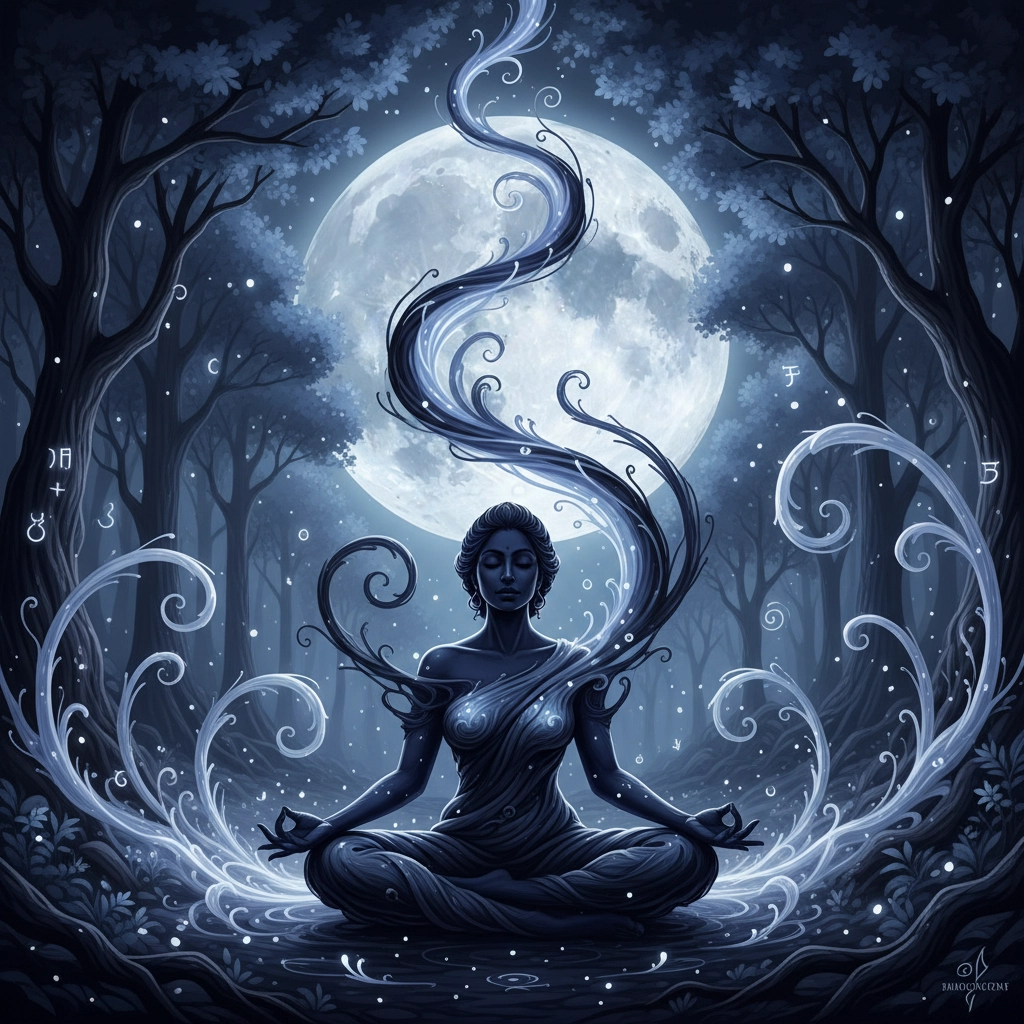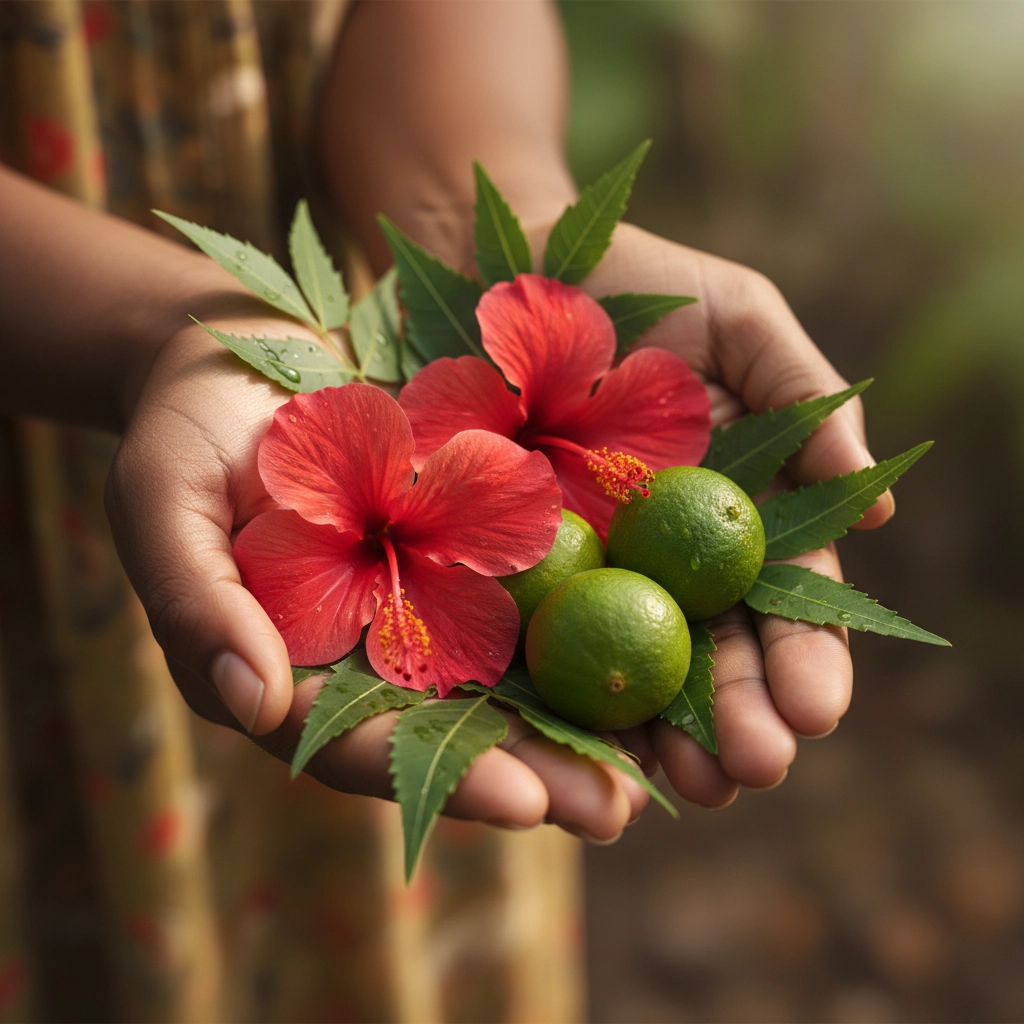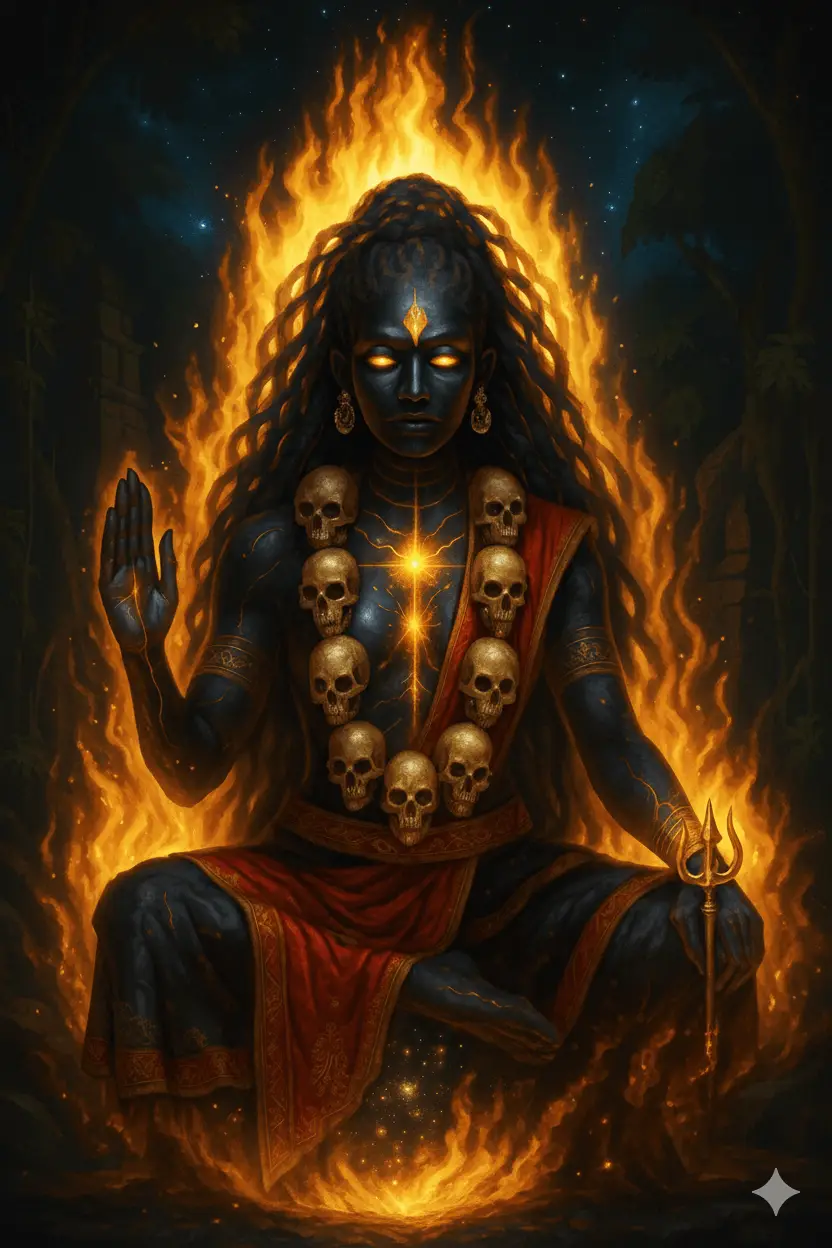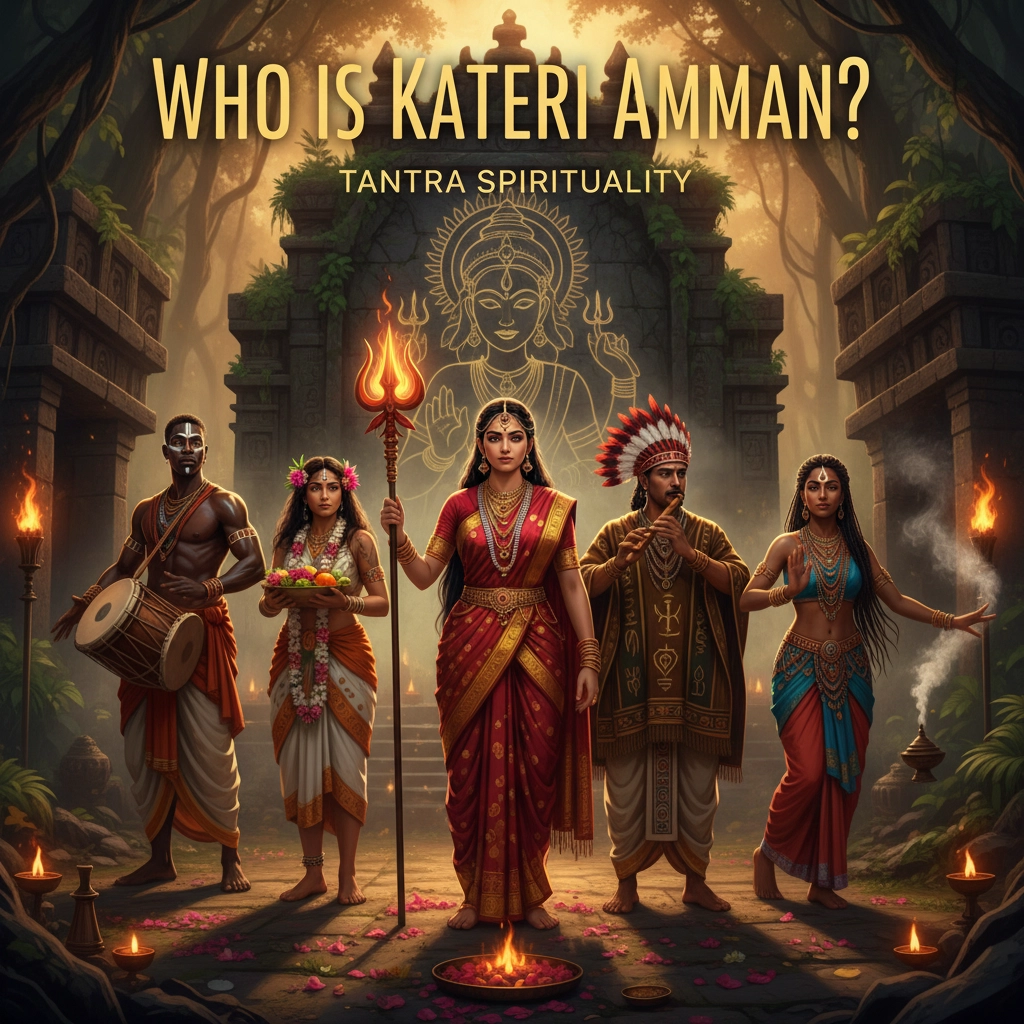Meet one of the most fascinating and complex goddesses you've probably never heard of. Kateri Amman (sometimes spelled Kaateri) is a fierce Mother goddess from Tamil and South Indian folk traditions who embodies everything tantric practitioners love about working with shadow energy, she's protective, transformative, and absolutely unafraid of the dark stuff we usually try to avoid.
Unlike the polished deities you'll find in mainstream Hindu temples, Kateri Amman comes from the grassroots, village-level spiritual traditions where real people dealt with real problems like disease, protection, and survival. She's raw, authentic, and incredibly powerful for anyone doing deep inner work.
Her Origin Story: Born from Shadow
The legend of Kateri Amman is basically the ultimate shadow work origin story. According to Tamil folklore, she emerged from a confrontation between Shiva and Parvati that reads like a masterclass in integrating your dark side.

Here's what went down: Shiva noticed his wife Parvati sneaking out at night and returning before dawn. When he asked about it, she claimed she never left his side. Curious (and probably a little suspicious), Shiva decided to follow her secretly.
What he discovered was intense, Parvati had been transforming into Kali's terrifying form, going to forests and consuming corpses. This wasn't random weirdness; in tantric understanding, this represents the divine feminine in her role as the transformer of death into life, the one who processes what needs to be released.
When Shiva confronted her, Parvati was filled with remorse. She promised to abandon this behavior and leave her terrifying form behind. The powerful shakti energy she left in that forest pit became Kateri Amman, a goddess who could handle the shadow work while maintaining a protective, nurturing aspect.
The Protective Fierce Mother
What makes Kateri Amman so relevant for tantric practitioners is her dual nature. She's simultaneously the nurturing mother and the fierce destroyer of what no longer serves. This isn't contradiction, it's integration.
In her protective aspect, Kateri Amman is known to work within the deepest parts of a devotee's body to remove sicknesses and blockages. She's invoked for healing, protection of children, and fertility. Village communities throughout South India have relied on her for generations when mainstream medicine and conventional spiritual practices weren't enough.
But here's where it gets interesting for shadow work: she doesn't just remove surface-level problems. Kateri Amman digs deep into the psychic and energetic roots of illness, trauma, and stagnation. She's willing to go into the dark places within us that other deities might avoid.
Her Fierce Shadow Aspect

The other side of Kateri Amman shows us why shadow work requires courage. In some Dalit folklore traditions, she's described as potentially dangerous if not properly honored, capable of causing harm to pregnant women or children when displeased. This isn't meant to scare you; it's a metaphor for what happens when we ignore or suppress our shadow material.
When we don't consciously work with our hidden aspects, our anger, our grief, our primal needs, they can emerge in destructive ways. Kateri Amman as the "dangerous" goddess represents the importance of establishing proper relationship with these energies through respect, offerings, and conscious engagement.
This is why tantric practitioners find her so valuable. She teaches us that fierce compassion sometimes requires boundaries, that protection sometimes requires saying no, and that healing sometimes requires getting uncomfortable.
Iconography and Symbolism
Kateri Amman is typically depicted with dark blue or black skin, which immediately connects her to Kali energy: the transformative aspect of the divine feminine that isn't afraid of darkness, death, or destruction. Her dark complexion represents her willingness to work in the shadow realms where real transformation happens.
Her weapons tell the whole story of tantric practice:
- Sword (aruval): Cuts through illusion and false beliefs
- Trishul (trident): Balances the three gunas (qualities of nature) and pierces through the three levels of ego
- Bowl: Receives offerings and symbolizes the receptive feminine principle
- Lotus: Shows beauty emerging from muddy waters: transformation through difficulty

Some depictions show her riding a horse, symbolizing her ability to move quickly between worlds and respond rapidly to devotees' needs. This makes her particularly appealing for people doing intensive inner work who need a goddess who can keep up with rapid transformation.
Connections to Tantric Practice
For modern tantric practitioners, Kateri Amman offers several powerful pathways:
Shadow Integration: Her origin story is literally about integrating disowned aspects of the psyche. Working with her energy can help you face parts of yourself you've been avoiding: your anger, your sexuality, your grief, your primal needs.
Body-Based Healing: Unlike more ethereal deities, Kateri Amman works directly in the physical body. She's perfect for tantric breathwork, body-based trauma healing, and practices that integrate physical and spiritual wellness.
Boundary Setting: Her fierce protective aspect teaches healthy boundaries. Many people in spiritual communities struggle with this: being too open, too giving, or too accommodating. Kateri Amman energy helps establish fierce compassion that protects what's sacred.
Ancestral Healing: Coming from village and folk traditions, she's deeply connected to ancestral wisdom and healing generational patterns. If you're working on family trauma or cultural healing, she's an powerful ally.
Folk vs. Mainstream Perspectives
Here's where things get really interesting. Kateri Amman has zero references in classical Hindu scriptures. She comes entirely from grassroots, village-level spiritual practice: primarily among Dalit communities and other marginalized groups who needed immediate, practical spiritual help.
This actually makes her more accessible for many Western tantric practitioners. She doesn't come with the complex theological baggage of Brahmanical Hinduism. She's not worried about caste, ritual purity, or following proper procedures. She responds to genuine need, honest offerings, and sincere engagement.

Her worship practices reflect this accessibility. Offerings include simple things like neem leaves, limes, red flowers, and sometimes alcohol or cigarettes: whatever represents genuine sacrifice or sharing from the devotee's life.
Working with Kateri Amman Energy
If you're drawn to work with Kateri Amman, here are some approaches that honor her folk tradition while supporting your tantric practice:
Start with Respect: Learn about her properly. She comes from specific cultural contexts that deserve acknowledgment, even as you adapt her energy for personal practice.
Offer What's Real: Instead of elaborate rituals, offer something that represents genuine sacrifice or sharing: your time, attention, or something you value.
Work with Shadow Material: She responds well to practitioners willing to face difficult emotions, traumatic memories, or disowned aspects of personality.
Body-Based Practice: Include physical offerings like dance, breathwork, or body-based meditation in your practice with her.
Protection Work: Call on her when you need fierce boundaries, whether in relationships, energy work, or life transitions.
Global Influence and Modern Relevance
What's remarkable about Kateri Amman is how her worship has spread globally with Tamil diaspora communities. She's now honored in temples and spiritual communities across Mauritius, the UK, Netherlands, Australia, Trinidad, Jamaica, and many other countries.

This global presence shows her relevance for people navigating between traditional cultures and modern life: exactly the situation many tantric practitioners find themselves in. She bridges ancient wisdom and contemporary needs without losing her essential fierce compassion.
For anyone doing serious inner work, Kateri Amman offers a powerful model: transformation that doesn't bypass difficulty, protection that includes fierce boundaries, and healing that goes to the root rather than just treating symptoms.
She reminds us that real spiritual growth often requires facing what we'd rather avoid, that the divine feminine includes both nurturing and destruction, and that sometimes the most profound wisdom comes not from ancient scriptures but from the lived experience of people who needed practical spiritual solutions.
In a world where spiritual practice can become overly sanitized or conceptual, Kateri Amman brings us back to the raw, transformative power that makes tantric practice so effective for real-world healing and growth.



